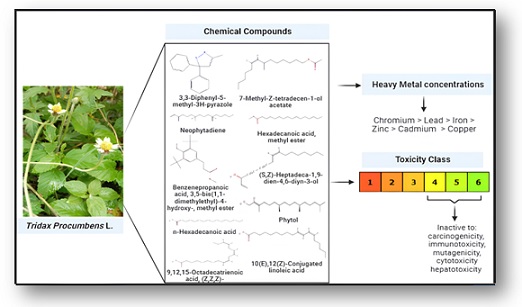Document Type : ORIGINAL RESEARCH ARTICLE
Authors
1 Graduate School of Mathematics and Applied Sciences, Universitas Syiah Kuala, Banda Aceh, 23111, Indonesia
2 Department of Pharmacy, Faculty of Mathematics and Natural Sciences, Universitas Syiah Kuala, Banda Aceh 23111, Indonesia
3 Department of Biology, Faculty of Mathematics and Natural Sciences, Universitas Sam Ratulangi, Manado, Indonesia
4 Faculty of Pharmacy, Universiti Teknologi MARA Selangor, Puncak Alam Campus, 42 300 Bandar Puncak Alam, Selangor, Malaysia.
Abstract
BACKGROUND AND OBJECTIVES: Tridax procumbens L. is a plant that grows abundantly in the Ie-Seu'um geothermal area in Aceh Province, Indonesia. The objective of this study is to determine metabolite compounds from Tridax procumbens plants in a geothermal area using qualitative and quantitative analyses. In addition, the contents of six heavy metals in plants and their toxicology were assessed using an in silico approach.
METHODS: The ethanolic extract of Tridax procumbens was analyzed qualitatively using reagents to determine the contents of secondary metabolites such as flavonoids, alkaloids, tannins, steroids, triterpenoids, and saponins. In addition, quantitative analysis was conducted using gas chromatography–mass spectroscopy to obtain the chromatograms and mass spectra of the metabolite compounds of the ethanolic extract of Tridax procumbens, which were used in computational toxicology analysis using a simplified molecular input system in a predictor server. Atomic absorption spectrometry was conducted to confirm the contents of six heavy metals harmful to medicinal plants.
FINDINGS: The results showed that Tridax procumbens from the Ie-Seu'um geothermal area, Aceh, has secondary metabolites such as flavonoids, saponins, steroids, and tannins, with phytol from diterpenoid group having the highest content (32.72 percent). Toxicological analysis showed that the compounds in the ethanolic extract of Tridax procumbens were nontoxic or inactive in five toxicity parameters. The other results of the heavy metal analysis showed the dominance of chromium among the other six metals tested (copper, not detected; cadmium, 0.91 ± 0.03 milligram per kilogram; zinc, 3.50 ± 0.03 milligram per kilogram; iron, 4.65 ± 0.02 milligram per kilogram; lead, 6.42 ± 0.05 milligram per kilogram; and chromium, 13.81 ± 0.07 milligram per kilogram.
CONCLUSION: This study highlights the unique secondary metabolite composition of Tridax procumbens under such extreme conditions and underscores the potential implications of heavy metal accumulation in plants in geothermal areas.
Graphical Abstract
Highlights
- Tridax procumbens is a plant that can survive in the Ie-Seu'um geothermal area;
- Chemical characterization and analysis showed the diversity of secondary metabolites present in procumbens;
- Ecotoxicological insights from metabolite compounds show negligible potential to be toxic to humans and the environment;
- In silico methods can be used to evaluate chemical compound toxicity.
Keywords
Main Subjects
©2024 The author(s). This article is licensed under a Creative Commons Attribution 4.0 International License, which permits use, sharing, adaptation, distribution and reproduction in any medium or format, as long as you give appropriate credit to the original author(s) and the source, provide a link to the Creative Commons license, and indicate if changes were made. The images or other third party material in this article are included in the article’s Creative Commons license, unless indicated otherwise in a credit line to the material. If material is not included in the article’s Creative Commons license and your intended use is not permitted by statutory regulation or exceeds the permitted use, you will need to obtain permission directly from the copyright holder. To view a copy of this license, visit: http://creativecommons.org/licenses/by/4.0/
PUBLISHER NOTE
GJESM Publisher remains neutral concerning jurisdictional claims in published maps and institutional affiliations.
CITATION METRICS & CAPTURES
Google Scholar | Scopus | Web of Science | PlumX Metrics | Altmetrics | Mendeley |
CURRENT PUBLISHER
GJESM Publisher



Letters to Editor
[1] Letters that include statements of statistics, facts, research, or theories should include appropriate references, although more than three are discouraged.
[2] Letters that are personal attacks on an author rather than thoughtful criticism of the author’s ideas will not be considered for publication.
[3] Letters can be no more than 300 words in length.
[4] Letter writers should include a statement at the beginning of the letter stating that it is being submitted either for publication or not.
[5] Anonymous letters will not be considered.
[6] Letter writers must include their city and state of residence or work.
[7] Letters will be edited for clarity and length.
Send comment about this article